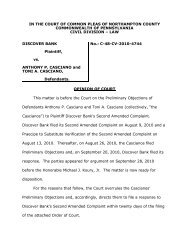OVERTIME AND COMPENSATORY TIME
OVERTIME AND COMPENSATORY TIME - Northampton County
OVERTIME AND COMPENSATORY TIME - Northampton County
You also want an ePaper? Increase the reach of your titles
YUMPU automatically turns print PDFs into web optimized ePapers that Google loves.
INTRODUCTION<br />
The country is currently in a state of shrinking revenues and escalating<br />
expenditures. During times like these, overtime can become an increasing<br />
concern to many organizations. As with any organization, good management<br />
practices require that overtime be managed in the most cost-effective manner<br />
possible. Overtime is a balance between meeting the needs of the organization,<br />
addressing appropriate staffing levels, and assigning staff to work the necessary<br />
overtime.<br />
The County adheres to the Fair Labor Standards Act originally enacted in 1938<br />
and has written Personnel Policies and collective bargaining agreements with<br />
those Federal guidelines in mind. Employees are compensated for their overtime<br />
by payment, usually at a premium rate, or by authorized time off in lieu of<br />
payment where specifically allowed.<br />
The County is currently in the process of implementing the SunGard financial,<br />
procurement and human resource/payroll software. This is the perfect<br />
opportunity to step back and analyze the current systems in an effort to improve<br />
upon the current limitations in processing payroll transactions.<br />
The Controller’s Office previously performed an audit of overtime and<br />
compensatory time dated August 15, 1996 for the calendar year 1995 and six<br />
months ended June 30, 1996. With a workforce of approximately 1,800 full and<br />
part-time employees encompassing 3 collective bargaining units, civil service and<br />
career service employees, total overtime costs amounted to $1,781,000 and<br />
$1,069,000, respectively. At that time, it was determined that an increased work<br />
force was not a viable option for reducing overtime due to the high cost of<br />
benefits.<br />
As of December 31, 2008, the County’s workforce was comprised of 2,152 full<br />
and part-time employees encompassing 11 collective bargaining units, civil<br />
service and career service employees with total overtime costs of $3,596,650 (as<br />
restated). The continual rise in overtime hours and the costs associated with<br />
overtime pay create a need to explore once again the cost benefits of hiring new<br />
employees versus current employees working overtime hours.<br />
2






